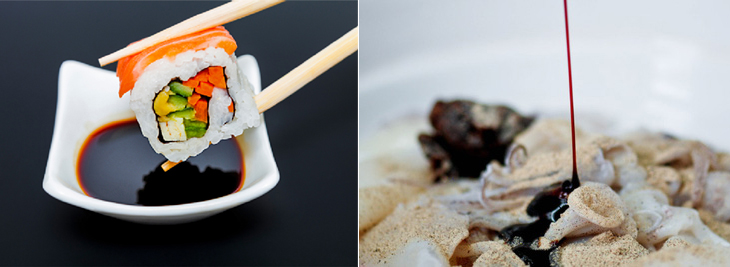Choosing the right soy sauce depends on its intended use
You may not have noticed, but soy sauces are distinctly categorized into two types: those for cooking and those for dipping. These two varieties differ in their production processes and hygiene standards.
– Dipping soy sauce: This type can be poured directly onto food as a dip or used in salads. Since it is consumed directly, the hygiene and safety standards for this variety are stringent to ensure no harm to one’s health.
– Cooking soy sauce: This variety is meant for cooking and must be heated (sterilized) before consumption. The hygiene standards for this type are lower compared to the dipping variety.

[captionnews]Distinguish between soy sauce for dipping and cooking[/captionnews]
Distinguish between traditionally fermented and formula-based soy sauce
Similar to fish sauce, soy sauce can be categorized into two types based on its production method: traditional fermentation or formula-based.
– Traditionally fermented soy sauce: Made by naturally fermenting soybeans.
– Formula-based soy sauce: Made using “hydrolyzed protein solution” (a solution of amino acids). If the processing technique is not up to par, harmful substances may be produced during the hydrolysis of proteins.
These two types differ in price and the quality of their aroma and flavor. While the traditional variety is generally considered superior, you can consider your habits, preferences, and intended use when making a choice.

[captionnews]Traditionally fermented soy sauce offers superior flavor and aroma[/captionnews]
Check the “amino nitrogen” content in the soy sauce’s composition
This indicator evaluates the quality of soy sauce (in terms of nutrition and taste). You can find it on the label affixed to the soy sauce bottle.
Typically, the higher the amino nitrogen content, the better the quality and more intense the flavor of the soy sauce. Based on this criterion, soy sauces can be classified into different grades:
– Quality soy sauce: Amino nitrogen content should not be less than 0.4g/100ml.
– Superior soy sauce: Amino nitrogen content can reach up to 0.8g/100ml.

[captionnews]Higher-quality soy sauce has a more intense flavor and color[/captionnews]
Check the origin and expiration date
Soy sauce is available in both domestically produced and imported varieties, which differ in price and quality. To ensure you’re getting the right product at the right price, check the origin (Japanese soy sauce is often highly regarded), brand reputation, and purchase from a reputable seller, especially for imported soy sauce.
Additionally, check the expiration date to avoid buying expired or soon-to-be-expired products that may be harmful to your health. Also, carefully inspect the packaging for any damage before purchasing, as soy sauce can spoil if the bottle is unsealed or the packaging is compromised.

[captionnews]Always inspect the product before purchasing[/captionnews]
Using soy sauce is a great way to add protein to your diet, and its flavorful taste goes well with Asian cuisine. Keep these basic guidelines in mind to choose a delicious, high-quality, and safe soy sauce.






























